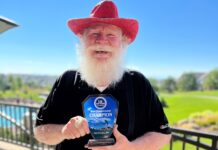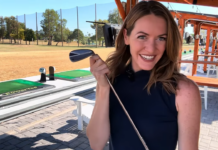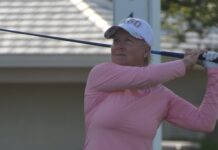Joran Meeks – a Certified Personal Coach with GolfTEC Upper Kirby in Houston – wanted to share his experiences at Pinehurst as his short game student Anthony Broussard prepared to compete in the Open for the first time.
Part 1: The Road to Pinehurst
I’m a PGA Member and I’ve been coaching for 12 years. It was while playing golf at Lamar University that I first met Anthony Broussard. At that time, he was just a young kid who would work on his golf game at the country club where our college team played.
Anthony and I quickly became friends and started regularly playing together. Playing with college players was beneficial for Anthony because he saw how we practiced and played and it helped him improve each year. He was a talented junior golfer and played high school golf at Beaumont Kelly where he won the state championship. Anthony received a full scholarship to the University of North Texas, where he had a very successful college career.
Anthony and I have always stayed in touch and had an enduring friendship. It was three or four years ago, that he asked me for help with his short game. Anthony was always a good putter, but once I assessed his game I decided to focus on making him an elite wedge player from inside of 100 yards.
Over the past two years, Anthony has become a very good wedge player and is now winning at the professional level. Over the past year, he has won on both the Hooters & Adams Tour. I believe it’s only a matter of time before he gets his PGA Tour card.
Anthony was one of the thousands of players who tried to pursue their dreams of playing in the US Open by competing at local and sectional qualifying events. In order to play at these qualifiers, players must have a Handicap Index that does not exceed 1.4.
Anthony competed in the local qualifier at Cedar Creek Golf Club in San Antonio. He did well at the event in Texas and carded a 66, which was the lowest score at the qualifier; this helped him advance to sectional qualifying at Lakeside Country Club in Houston.
Anthony needed to birdie 17 and 18 on his afternoon round to advance to a playoff. On the second playoff hole, he was able to stick his approach shot within a few feet of the hole. He proceeded to roll the putt in for birdie, thus, successfully securing his spot at the US Open.
I have known Anthony for 18 years and I look forward to helping him prepare this week for Pinehurst. My focus will be assisting him by finding the proper wedges for the turf at Pinehurst; we will test several different grinds first thing Monday morning. I expect the turf to be firm and tight, so the correct wedge grind is essential for the techniques we work on during our lessons.
Part 2: Sunday Before the US Open
After catching a flight to North Carolina, I arrived at Pinehurst Sunday afternoon. I traded some text messages with Anthony who was already on the course. I caught up with him on the back nine. He was playing a practice round with Keegan Bradley and Jason Dufner. It’s every golfer’s dream to get a chance to play a practice round at the US Open; much less with some of the nicest guys on the PGA TOUR.
Anthony was really hitting it well. He was hitting most of the fairways and even hit a tee shot a few yards by Keegan Bradley on the 18th hole. I knew I was in for a great afternoon! Jason Dufner has a reputation for being one of the funniest guys on TOUR. He didn’t let us down with his dry sense of humor. One of the funniest moments was on hole #16. He pulled his drive left and missed in 2nd shot into the right bunker short of the green. This left him in a bunker shot of about 40 yards from the green to a tucked pin. If you are not aware, Pinehurst #2’s greens are all turtle back. The pin was shoved back left on a downhill slope. Anything past the pin would run off the green down into a little valley. Duff hit an amazing shot to about 2 feet with a PW. All of us were in awe and Jason knew it! In his dry sense of humor he looked over to Anthony and me and said, “Right now you are thinking to yourself, how did he just do that and you’re trying to wrap your brain around it”. It was really funny the way he said it. The next day, Monday, we walked past Dufner on the range and he gave us a little grin and said “Your still thinking about that shot aren’t you!” We finished up the round, hit a few short game shots around the practice area and called it a night.
Monday of US Open Week
I knew this would be our biggest day of preparation before the tournament started. The day before we noticed the course was cut in a way that all lies around the greens would play into the grain. This means shots would easily run off the green and chips shots back on would be more difficult than your usual course because the club wants to stick in the turf. I knew we would need a different grind on Anthony’s wedge to deal with these conditions. Anthony set up a meeting with Bob Vokey and his lead fitter and wedge grinder, Aaron Dill for 8AM. We worked around the short game areas for about 2-3 hours trying to figure out what grind was best. It was a great experience for both of us. After a lot of work between the team, Anthony ended up with a Titleist TVD 58 bent to 60 with a rounded leading edge to take the sharpness out. The Titleist team also softened the trailing edge by trimming some of the bounce in the heel. This would keep the back of the club from grabbing when he opens the face. The grind actually ended being a mixture of the M Grind and the K Grind. For all you who follow grinds, this is an M grind on steroids.
After working around the greens in the morning we made our way to the practice tee where it was crowded with players. We hit balls for about an hour before we decided to go play and try out the new wedge. We met up with long time TOUR Pro Rod Pampling. We played 9 holes with Rod and Anthony was hitting some nice pitches and chips with the techniques we have worked on. As we walked down the fairways together everyone talked about how a US Open is designed to test the mental strength of a player. He was going to need to accept that he might hit a perfectly executed shot and miss the green. That was all part of it. On the range earlier, I got into a conversation with some of the caddies who mentioned a course like this would only yield 11-12 greens in regulation to even the best ball striking efforts. I knew this was some feedback I needed to get into my players head. After the front nine, we spent the second 9 holes working on shots around the greens. We hit pitch shots from every scenario that he might face. Anthony is one of those players who is very Type A. He believes if he has practiced every situation, he feels prepared for what the tournament will bring. After a long day of practicing, we called it a day.
Tuesday of US Open Week
The morning was spent working with the new wedges again. We worked around the short game practice area by the first tee this time because it seemed to have more into the grain lies that were common on the course. I wanted him to work on his trajectory and spin control. We started with shorter chips and worked all the way up into mid/high lobs. The new course is not like past US Open Championships, with very deep rough around the greens. Every lie is very hard and tight so this is where we spend a majority of our time. Outside of the tightly mown areas are native grasses with a sand base. Those could be played similarly to bunker shots in some cases.
Read about some of the changes at Pinehurst here:
http://blog.golftec.com/a-drastically-new-look-for-pinehurst-2-at-this-years-us-open
As you can see from the videos. The lower shots are controlled with a quiet hand motion & little to no hinge. Anthony thinks about turning his chest back and through all while keeping the hands in front of the body. For the low trajectory spin shots, he puts a little more speed into the follow through. For those he wants to run out, he keeps the speed constant and his hands softer.
As we move to the higher shots or lob type shots, he uses his hands slightly more but still has a nice rotation of the body. As you can notice in the follow though, he is really “sawing” the finish off. This is to help with the spin as well as keep the face open to make sure the bounce hits the turf first, instead of the leading edge. This is something amateurs can learn from the pros, it’s not a good idea to put the hands and weight forward at address when dealing with higher shots or lobs. This makes the leading edge catch into the ground and can lead to fat or thin shots. I would like to see a more neutral weight and hand placement and an open face on these shots. Then when coming into contact, make the base of the club hit the turf slightly behind the ball, instead of the leading edge. This action will work best if you have the proper bounce on your wedges. Bounce may vary based on your motion or angle of attack as well as your playing conditions. Getting fit for the proper wedges is crucial to being able to perform these techniques.
Wednesday of US Open Week
I‘m back in Houston and feel Anthony is as prepared as possible for his first round Thursday morning. He had a light day of practice and final touch ups with all facets of his game and says he feels great. His short game is in excellent form. I got him more shallow with his pitch shots and he is getting that good crisp contact with all short shots around the greens. He has that nice thump sound you strive for when hitting bunker shots and he is able to use every trajectory necessary for the Pinehurst terrain. Today was much shorter in terms of hours spent at the facility so he could be well rested for the big day Thursday. I’m glad he tees off in the morning so he doesn’t have to sit around the room thinking about it too much. One thing I have realized in my years spent playing and teaching golf is that you play better when your mind is at ease and you don’t have too many anxious thoughts. My hope is that Anthony can deal with the initial nerves of actually being on golf’s biggest stage and one of it’s hardest venues and just play his game.
It is hard to describe how tough Pinehurst is set up from the firmness, the slope around the greens, the native areas, thickness of the sand in the bunkers, etc. It is easy to see why many of the world’s best players shoot in the 80’s at the US Open every single year and why even par seems to be the goal for most players and often times the winning number. I have stated several times that you can hit very good shots and end up with very bad results, that is just part of playing in the US Open. The players that can hang in there mentally and survive the grueling conditions are the ones that always have a chance to win or even make the cut. As I walked the grounds I imagined what a 10 handicap would shoot in the same conditions that the US Open contestants will face and I can’t come up with a score under 95. It’s just that tough with a huge emphasis on every single shot. As you all watch the coverage for Thursday don’t be surprised if you see some huge numbers by great players; it is inevitable.
Podcast: Play in new window | Download













